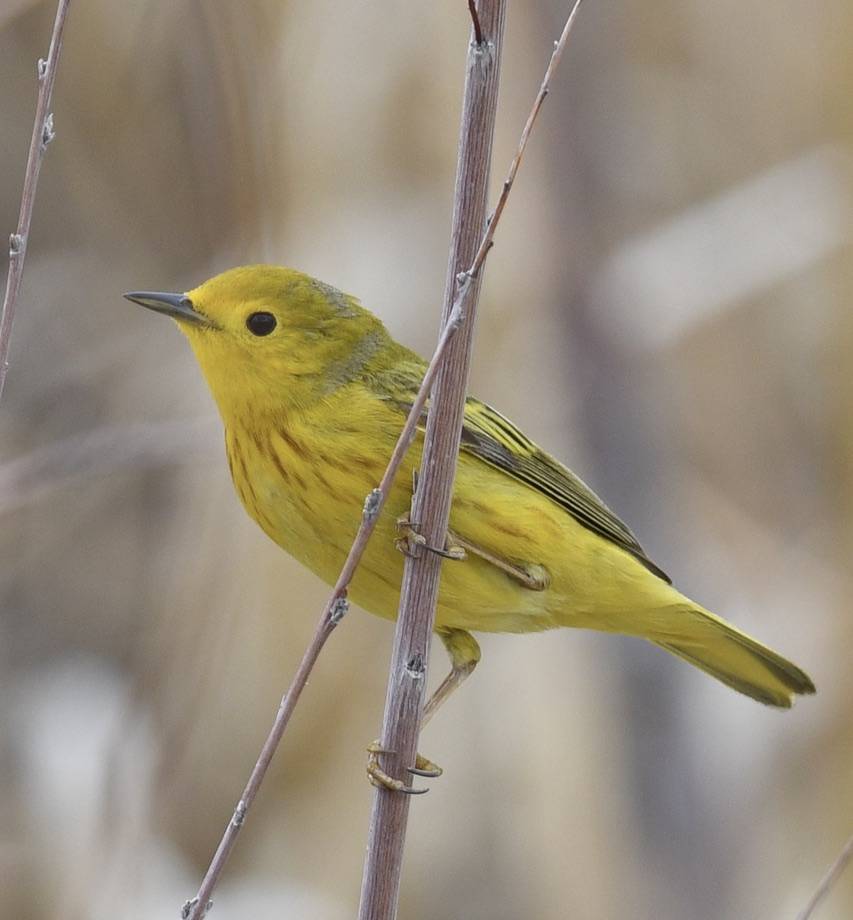Sunriver’s Autumn Colors – Wood Warblers
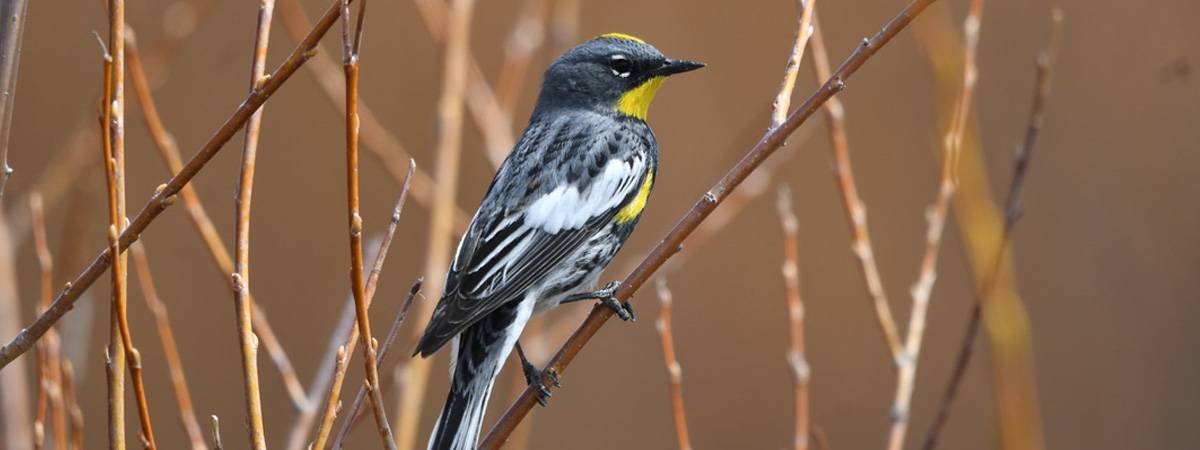
By Sevilla Rhoads
Thank you to Chuck Gates for his time reviewing our bird blog posts for accuracy.
In autumn, Sunriver’s conifers may not turn the brilliant colors of deciduous trees like Maples, but our forests have their own fall show: Migrating warblers. Starting in late summer, especially in the mornings as the Fall mists rise from the rivers and streams, you may notice shrubs and trees, particularly along waterway edges, twitch and rustle even when there is no breeze. No, Sunriver’s plants are not trying to give you a pre-Halloween scare. Pause and quietly peer into the foliage shadows. You will likely start to see flashes and streaks of yellow deep within. Stay still, and soon will emerge little fluffy heads with dark eyes, furtively checking for predators before hopping out to grab insects. You will be amazed that all these brightly colored and fast-moving birds, now dashing about picking bugs off leaves and out of the air, were almost invisible just moments before.
In the mornings at this time of year, thousands of warblers sneak about Central Oregon’s vegetation. While desperately trying to avoid predators, they eat as much as possible to fuel their grueling migration journeys. Most of these birds flew all night before dropping down to hide and feed in places like Sunriver’s willows, grasses, and pines.
According to BirdCast, the night before I wrote this post (September 20th), an estimated 285,300 migratory birds flew over Deschutes County. On average, they were about 1,200 feet up and traveling south-southwest at a speed of around 19 miles an hour. If you are curious how many birds flew over you last night, you can put your county name into the Birdcast search box and find out: https://birdcast.info/
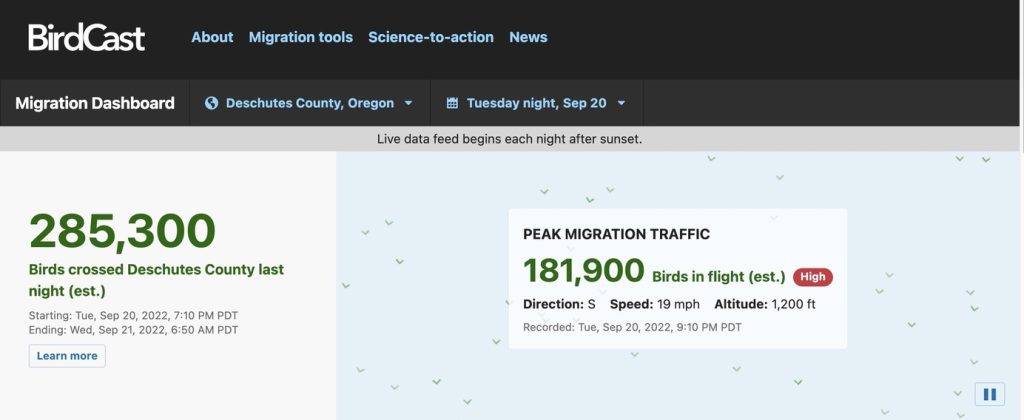
If you wake up during the night in autumn, consider opening the window and listening. If it is quiet enough, perhaps you will hear the soft calls from the thousands of birds passing over you. Warblers constantly call each other during these night flights for reasons not entirely understood by researchers.
Look at the moon, especially with a telescope or binoculars. You may make out the shadowy movement of these vast flocks. Some birds could fly lower down and pass right outside your window.
You may notice most of us in the Sunriver area turn off our outside lights at night, and there are few street lamps. Scientists think birds migrate at night primarily to navigate by the stars, so they need us to reduce the amount of artificial light during migration season. Other reasons for nocturnal travel are more favorable winds, cooler temperatures, and fewer aerial predators. https://www.birdnote.org/listen/shows/nocturnal-migration-songbirds.
Several great places to watch in the mornings for the warblers that have dropped down from their night flights are the footbridge by the Sunriver Resort where the bike trail goes towards the airport and also the bridge over the Deschutes at the Benham Falls East day use/trailhead. The willows around these bridges are often full of birds during migration season.
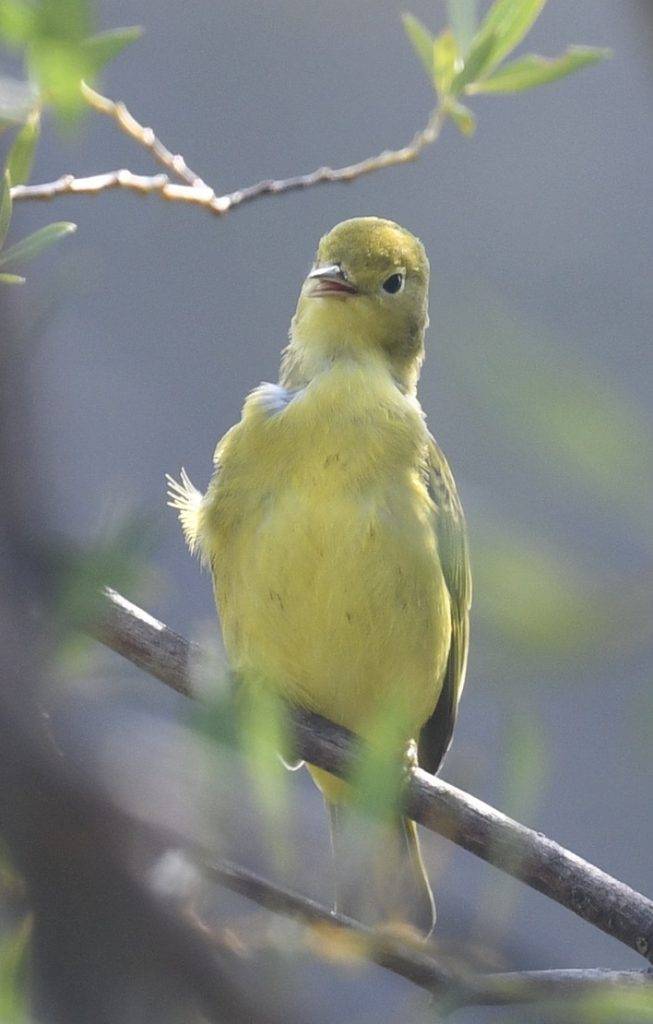
Watching Sunriver’s autumn warbler show, we are fairly certain we see every shade of yellow possible. Especially during September, there are young birds in varying stages of developing plumage, and many adults are molting. These changes in feather color can make it hard to identify the species. Still, the scruffy and motley birds, often leaving little puffs of feathers in their wake, are fun to watch.
There are quite a few species of warbler that live and migrate through the Sunriver area. Most commonly seen in Sunriver are the Yellow-rumped, Yellow, Orange-crowned, Common Yellowthroat, and Wilson’s Warblers. The Nashville, Townsend’s, and MacGillivray’s Warblers are a little less often seen here. The Black-throated Gray and Hermit Warblers are uncommon.
Here is a US Forest Service guide to warblers in Central Oregon: https://www.fs.usda.gov/detail/deschutes/learning/nature-science/?cid=stelprdb5274681
If you are interested in seeing the less common warblers, you only need to head a half hour or so into the higher elevation areas of the Deschutes National Forest to places like the Fall River Guard Station, North and South Twin Lakes, Crane Prairie and along the Deschutes in the Wickiup area. Consider checking the local eBird map to see where birders are finding the species you hope to see.
In Sunriver, the Yellow-rumped is the most visible of our resident warblers. Affectionally called ‘Butter Butts’ by birders; these handsome birds seem to be the least shy warbler. They sometimes sit out in the open, watching for opportunities to catch a bug or chase a rival. Warblers mainly feed by picking insects off plants but can also catch prey on the wing.
Yellow and Orange-crowned can be shyer than Butter Butts. Still, they will come out into the open to grab an irresistibly tasty-looking caterpillar. Especially during the breeding season, Yellow Warbler males have red streaks down their chests as if they flew through a wet paint sunset, but in the autumn, their breasts sport varying shades of yellow, so they look like fluffy lemons in all stages of ripening!
We hardly ever see the orange crown of an Orange-crowned, so do not be misled by the name when trying to find one. Where Yellow Warblers are a study in yellows with touches of green (mostly on their backs), Orange-crowneds pick up the color study on the green end of the yellow spectrum such that they are a feast of olive tones. If you see an Orange-crowned foraging in our local Willows, they precisely match this plant’s hues.
With their stylish black berets, male Wilson’s Warblers look like they should be carrying a baguette under one wing. In the autumn, some males have black flecks rather than caps, so they and the females can look much like Yellow Warblers.
You are not alone if you confuse Yellow, Orange-crowned, and Wilson’s Warblers! Sometimes, especially in the autumn, it is hard to tell them apart because they overlap in their overall color and size. If you feel up to the challenge of accurate identification, there are subtle differences in eye ring shape, under tail color, bill size, and markings, but you can also just sit back and enjoy them without knowing who is who.
Common Yellowthroat Warblers lurk in the riverside shrubs like bandits ready to ambush. When the males suddenly emerge, their black masks are startling, offset by white and yellow. But don’t blink in surprise for too long because they quickly turn their grey-green backs on you and dash back into the shadows. The females usually keep a low profile and look quite different than their flashy partners.
If the warbler you’re admiring seems to have a brighter white eye ring and the gray head coloration seems more pronounced, you might be seeing a Nashville or a MacGillivray’s. These ‘hoody’ birds can suddenly pop out of the brush with an astonished look. The surprised look is due to their bright white eyeliner, which is entirely around the Nashville’s eye and in two halves around the top and bottom of the MacGillivray’s eye.
Most often higher up in the pine trees, you can sometimes spot a Townsend’s Warbler around Sunriver. They have striking black and yellow facial markings.
If you see a similar warbler without the Townsend’s clearly defined face stripes, it could be a juvenile or female Townsend’s or the even less often seen Hermit Warbler. Hermit Warblers are actually relatively common and numerous in our forests, but they live up to their Hermit name by usually staying far up in the canopy silhouetted against the sky.
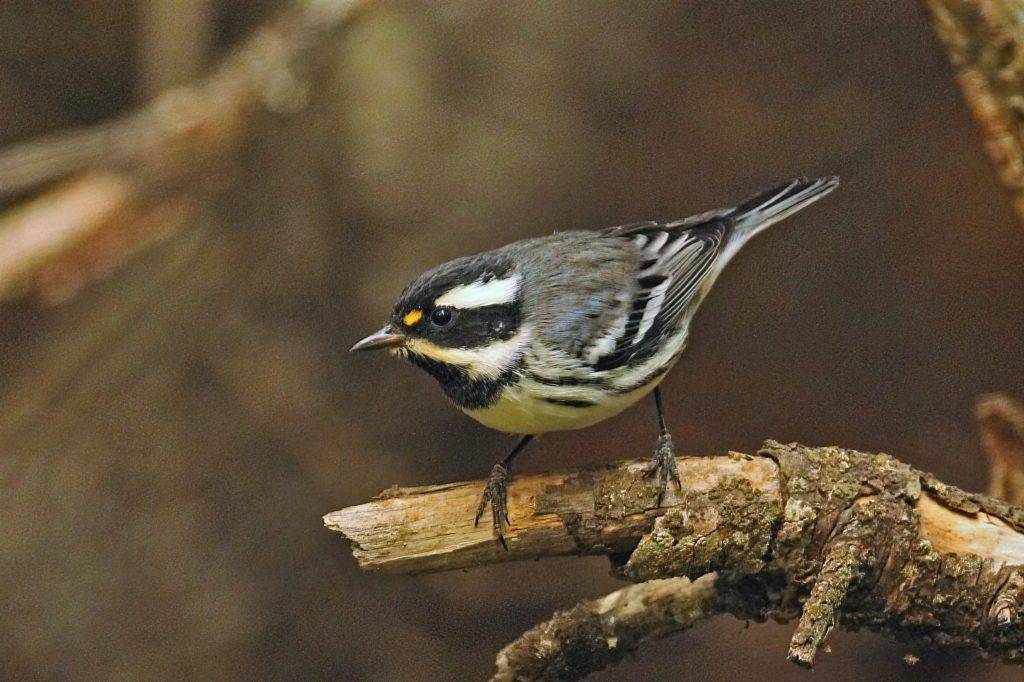
A real treat for Sunriver birders is spotting the Black-throated Gray Warbler. At first glance, you might mistake this bird for a Mountain Chickadee with its overall black, gray, and white appearance, but look more closely because the shape and markings are different. And, there might be a little yellow dot behind the bill.
Finally, a rare warbler comes through this area every now and then. For various reasons, some warblers stray from their usual migration route, ending far beyond their expected range. It is exciting to discover one of these vagrants. For example, last year a ten year old walking with his family just south of Sunriver, found a Bay-breasted Warbler which turned out to be the first ever recorded sighting of this species in Central Oregon! So, if you can’t identify a warbler using a western species list, check a guide showing all North American warblers, just in case….
Ready to go out and enjoy the fall warblers? Here is a fun guide to watching (and drawing) warblers written by Christine Elder, a local nature illustrator and educator: https://christineelder.com/warblers/.
Also, Sunriver Nature Center offers guided bird walks – just call and ask about ways to join local birders and Center educators. Everyone is welcome at the Nature Center and there are walks for all skill levels.
